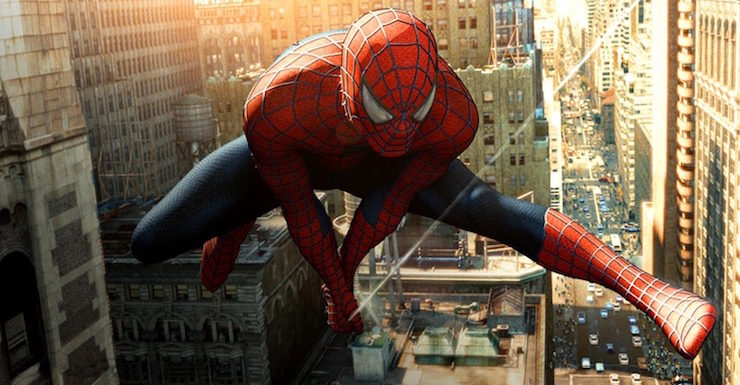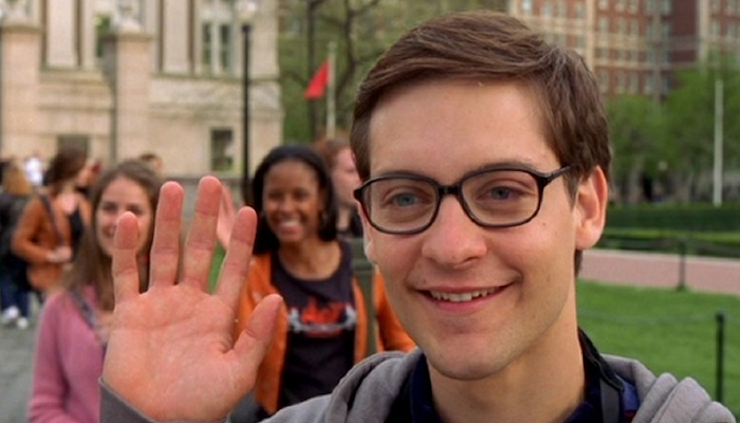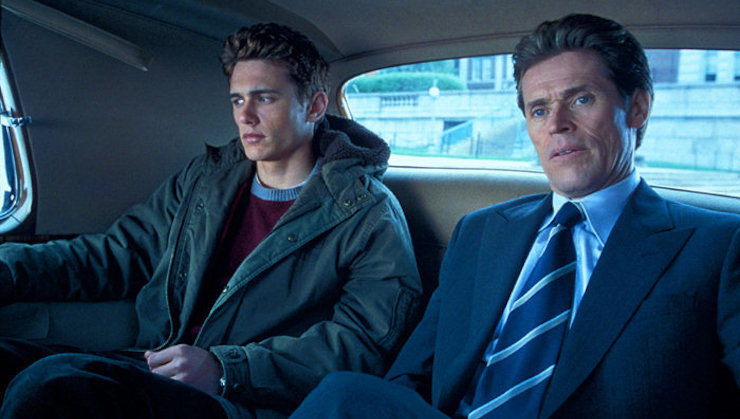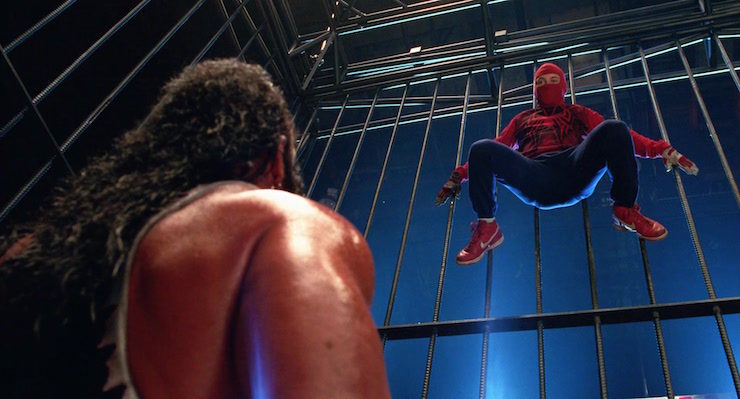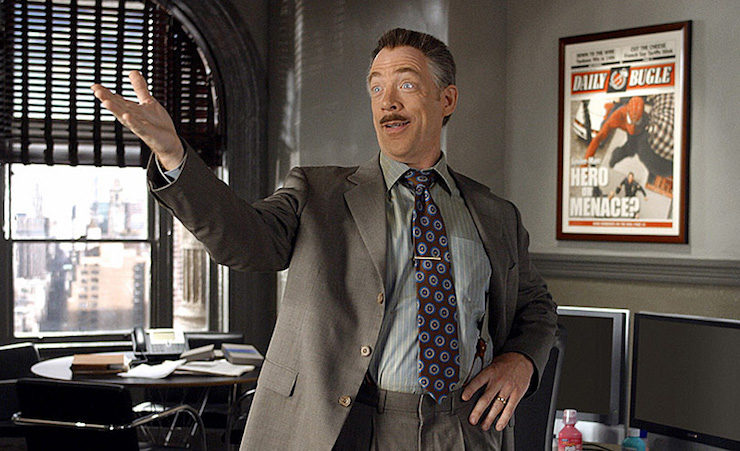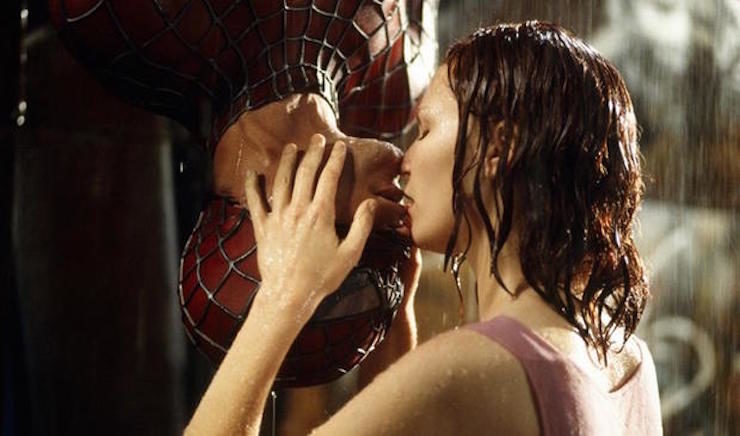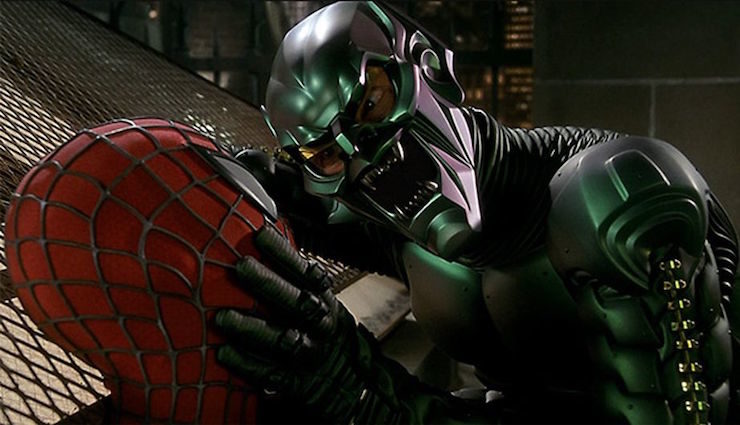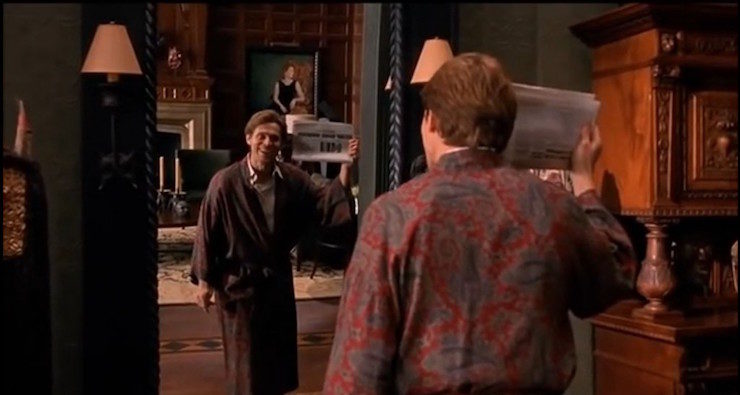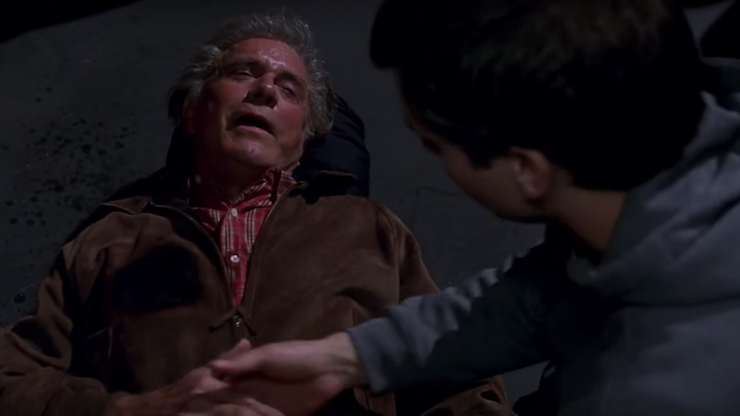Created in 1962 as part of the big wave of superheroes that began in 1961 with Fantastic Four, Spider-Man proved to be one of Marvel Comics’s most successful characters. A teenaged nerd who was made fun of by the jocks, an orphan raised by his elderly aunt, and a young man with an overdeveloped sense of responsibility thanks to his indirect involvement in the death of his uncle, and also one of the funniest heroes around thanks to his predilection for witty banter, Spider-Man quickly became Marvel’s flagship character.
In the late 1960s, several Marvel characters were adapted into animation, with Spidey’s being by far the most popular (and getting an iconic theme song), and the character continued to show up on TV in either live-action or animated form through the 1970s (the Nicholas Hammond live-action show), 1980s (Spider-Man and His Amazing Friends), and 1990s (Spider-Man: The Animated Series).
But it wasn’t until 2002 that he got his own theatrical release, though it wasn’t for lack of trying for 25 years…
Initially, Roger Corman had the option to do a Spider-Man film, and I think we can all count our lucky stars that that option expired, given what Corman did to the Fantastic Four. It was then with Cannon Films from 1985 until the company went under in 1989, and Cannon’s Mennahem Golan kept the rights to Spidey with his new company 21st Century Film Corporation in lieu of a buyout when the desiccated remains of Cannon were sold to an Italian company.
The initial director attached by Cannon was Tobe Hooper, who misunderstood Spider-Man as being a teenager who was turned into a giant spider monster. Stan Lee then wrote his own treatment for a Spidey film that hewed a bit closer to the comics, and various scripts based on that treatment were written, each one with a smaller and smaller budget in mind as Cannon collapsed under its own weight. (One particularly brutal budget slash occurred after the abject failure of Superman IV: The Quest for Peace.) Lee’s movie treatment would later be adapted by Peter David into a novella that appeared in the 1994 anthology The Ultimate Spider-Man, published by Berkley Books (which also included your humble rewatcher’s first-ever work of published fiction, the story “An Evening in the Bronx with Venom,” co-written with John Gregory Betancourt).
CarolCo started developing a film written and directed by James Cameron, and that led to years of legal wrangling between CarolCo and 21st Century, as Golan and Cameron seemed to have competing version of a Spider-Man film happening. Or, rather, not happening.
Eventually, Columbia Pictures wound up with the rights as part of a weird rights-swapping thing with MGM (CarolCo’s parent company) involving the James Bond films. Columbia acquired everything Spidey that had been done up until then. David Koepp was hired to write a new script, which was based on Cameron’s detailed treatment. Rewrites were done by Alvin Sargent and Scott Rosenberg, but ultimately Koepp was given sole credit with the blessing of Sargent, Rosenberg, and Cameron.
Brought in to direct was Sam Raimi, who grew up reading Spider-Man comics and was a huge fan of the source material, which at the time made him pretty much unique among directors of a comic-book property. Luckily, this would change in subsequent years…
“You’re not Superman, you know…”
Spider-Man
Written by David Koepp
Directed by Sam Raimi
Produced by Laura Ziskin and Ian Bryce
Original release date: April 29, 2002
We first meet Peter Parker as he’s running for the school bus that will take him to Midtown High. The driver takes a sadistic glee in not stopping, said glee shared by everyone on the bus except for Mary Jane Watson. MJ is Peter’s next-door neighbor, and he’s had an unrequited crush on her since he was six. However, she’s dating the class jock, Flash Thompson.
Peter’s only real friend is Harry Osborn, the son of Norman Osborn, the very wealthy head of Oscorp. But Harry doesn’t take the school bus, he gets chauffeured to school. Harry has washed out of every private school Osborn has sent him to, and Midtown High is his last chance.
The kids take a field trip to Columbia University, where they get to see their genetic engineering lab. There’s a gigunda electron microscope, and also fifteen genetically engineered “super-spiders.” Both Harry and Peter see MJ getting annoyed with Flash, but Peter is too nervous to approach her. Harry instead uses some facts about the lab that Peter told him to impress her, to Peter’s annoyance.
However, Peter is taking photos for the school paper (Flash and his friend keep bumping him while he tries to take pictures), and he uses the need for a picture of a student with the science stuff as an excuse to talk to MJ and take pictures of her.
One of the “super-spiders” has gotten out of its cage and it bites Peter on the hand.
Oscorp has a contract with the military, and their latest project is a performance enhancing formula that combines with an exoskeleton and a jet-glider. Unfortunately, there are concerns about the side effects of the formula. The general in charge of the contract—who inherited it from his predecessor—gives Osborn a week to perfect it or he’s pulling funding and giving the contract to Quest, Oscorp’s greatest competitor.
Peter returns home to his aunt May and uncle Ben, begs off dinner, and collapses in bed, feeling very poorly. However, he wakes up the next morning to discover that he’s got greater muscle tone, he no longer needs his eyeglasses, and he’s generally stronger and more energetic. At school that day, he rescues MJ from slipping on a wet floor, and discovers that he can shoot webbing from his wrists. He accidentally webs a tray of food into one of the kids.
Flash picks a fight with Peter, and Peter actually wins it, to everyone’s shock. Peter runs away from the school, a little frightened. He realizes he can stick to surfaces and is able to climb walls. He figures out how to control his web-shooting ability, and very soon is swinging around Queens like Tarzan.
He finally gets home, having totally forgotten his promise to Ben to help paint the kitchen. He does, at least, take out the trash, and hears the latest loud argument next door in the Watson house. MJ goes outside to get away from the shouting and she and Peter have a nice talk that is interrupted by Flash arriving in his cool new car. Peter decides that he needs a car to impress her, and finds two ads in the paper: one for a car that costs just under $3000, and one for a wrestling competition against “Bone Saw” McGraw—stay in the ring with him for three minutes, and you win $3000, the more colorful the opponent, the better.
Peter says he’s going to the research library on 42nd and Fifth, and Ben offers to drive him so they can talk. Ben is worried about him, missing chores and getting into fights, but Peter blows him off, even reminding him that he’s not really Peter’s father. Ben cautions him that with great power comes great responsibility, which will probably be important later.
Peter then goes to the arena where the wrestling is being held. Bone Saw makes short work of his opponents. Peter, wearing a red sweatshirt emblazoned with a spider, a red ski mask, red gloves, blue pants, and red boots, and calling himself “the Human Spider,” enters the $3000 competition. The MC thinks “the Human Spider” sucks as a name and instead introduces him as “Spider-Man.”
After Peter commits the world’s biggest upset by disposing of Bone Saw in two minutes, he’s then only paid $100, because the deal is to stay in the ring with him for three minutes. As Peter walks away, dejected, someone robs the box office. He escapes by running past Peter, who holds the elevator door for him. Peter takes great pleasure in screwing the guy who screwed him.
He changes clothes and heads back to the library, only to find that Ben has been carjacked and shot. He dies in Peter’s arms, and then Peter goes after the perp. The cops and Peter both chase him to an abandoned dock, where Peter is horrified to discover that the person who murdered his uncle is the same person who stole the wrestling box office receipts. The person he could have stopped, but chose not to, and Ben paid the price.
Back at Oscorp, Norman Osborn decides to test the formula on himself. It gives him enhanced strength, but he also gets the side effect of insanity to go with it. In a mad rage, he kills Dr. Mendel Stromm, one of his head scientists, and also makes off with the jet-glider prototype and the exoskeleton. However, when Harry finds him later on the floor of his study, he has no memory of it.
In honor of Ben, Peter puts together a better costume, er, somehow and starts saving people’s lives and generally stopping crimes as Spider-Man. He also graduates high school, earning a science award. Osborn is pleased to see that Harry actually graduated, and rents an apartment downtown for both Harry and Peter to share, as Osborn views Peter as a good influence on his son. MJ, meanwhile, breaks up with Flash and gets a job as a waitress at a diner while auditioning for roles, pursuing her dream of acting. She also starts dating Harry, something Harry neglects to tell Peter.
Daily Bugle publisher J. Jonah Jameson thinks Spider-Man is a vigilante menace, but he also sells papers, so he continues to put him on the front page. He’s also frustrated at the lack of good pictures, and puts out word that he’ll pay top dollar for good pictures of him. Peter sees this, and makes sure to set up a camera with a timer when he stops an armored truck robbery. He sells those pictures to the Bugle.
Using the jet-glider and exoskeleton, the latter modified to look like a green goblin, Osborn kills the general and several officers of Quest, as well as their exoskeleton prototype. Thinking it will eliminate the competition, Osborn is horrified to realize that his actions have prompted Quest to make an offer to buy Oscorp, replacing the lost resources from the attack with Oscorp’s—their condition being that Osborn himself be removed from the company. The board of directors has unanimously accepted this offer.
Livid, Osborn puts on the armor, boards the jet-glider, and attacks the World Unity Fair in Times Square that Oscorp is sponsoring. He kills the entire board of directors, and almost kills several more people, including MJ, but Peter is there taking pictures for the Bugle, and changes into Spider-Man to save the day. (Though one girl is saved by an older man who looks just like Stan Lee.)
On Thanksgiving week, the Goblin attacks the Bugle, wanting to know who it is taking the pictures of Spider-Man. Jameson doesn’t give Peter up, insisting even as he’s being strangled that they’re sent anonymously by mail. Spidey himself shows up—Peter was in the building already dropping off more photos—and Goblin gasses him, bringing him to a rooftop and offering him a partnership. Spider-Man refuses and manages to get away, though one of Goblin’s weapons cuts his arm.
Harry and Peter host Thanksgiving dinner at their apartment, cooked by May, and with Osborn and MJ attending as well. Peter is late, of course, and Osborn realizes that Peter is Spider-Man when he sees the cut on his arm that’s in the exact same place the Goblin cut Spider-Man. Osborn leaves in a huff, pausing to decry MJ as a fortune-seeker who only cares about Harry’s trust fund and not him. Harry’s complete failure to defend MJ leads to her leaving in a minute-and-a-huff.
Peter meets MJ after an audition, and then he saves her from being mugged as Spider-Man. MJ insists on kissing Spidey.
Osborn figures the way to get at Spider-Man is through his loved ones, so he damages May’s house and injures her badly to frighten her.
While visiting her in the hospital, MJ declares that she has a crush on Spider-Man, and Peter admits that he “knows” Spidey (claiming to be his unofficial photographer), and tells MJ what he thinks of her, by way of what he told Spider-Man about her. They wind up holding hands, which is, of course, when Harry walks in. Harry leaves in a couple of huffs and goes home and tells Osborn that MJ is in love with Peter, and Peter has loved MJ since he was a tiny tot, and Osborn pumps his fist and says, “YES!” as he now has a way in to Spider-Man.
He kidnaps MJ and takes her to the Queensboro Bridge, making sure Peter knows he took her. He sabotages the Roosevelt Island tram and drops both the tram and MJ toward the water and tells Spidey he can only save one. He manages to save both, aided by the people on the bridge who show solidarity with Spider-Man by throwing detritus at the Goblin, and two guys on a barge on the East River, who maneuver under the tram and catch it and MJ both.
Once the people are saved, Spidey and Goblin’s fight takes them to the abandoned mental hospital on Roosevelt Island where the fight gets brutal. Goblin reveals himself to be Osborn and he pleads with Peter to help him, as he can’t control what the Goblin does. But Peter can’t get past all the people he’s killed and he continues to fight. Goblin tries to impale Spidey on his jet-glider’s blade attachment, but Spidey dodges it at the last minute and it guts Osborn instead.
Osborn’s last words are “Don’t tell Harry,” so Peter removes the Goblin armor and leaves Osborn’s body at his home. Harry walks in on Spidey as he’s putting the body down. Later at the funeral, Harry blames Spider-Man for his father’s death. Peter realizes that Spider-Man will always have enemies, so when MJ declares her love for Peter, he says that he can only be her friend. But they do kiss, and MJ touches her lips afterward, as if that kiss is vaguely familiar…
“I missed the part where that’s my problem”
There are very few things I’m grateful to The Matrix for, but one was that, watching it in 2000, I realized that technology had finally reached the point where Spider-Man could be done convincingly in live action.
And this movie proved me right two years later, as—unlike Nicholas Hammond’s stunt double—the actions of Spidey in this, aided by what was then state-of-the-art CGI, looked like what Spider-Man is supposed to look like. The web-slinger’s acrobatics are very unique, and also pretty much impossible for a real human being to manage. (In the comics he always looks like someone has folded his spine in half.)
Watching it again sixteen years later, the CGI isn’t always quite as seamless as it seemed then, but it still works, mostly because Spidey is so fast-moving and almost ethereal in his acrobatics that the weightlessness of turn-of-the-millennium CGI works in its favor.
The casting in this movie was pretty much perfect across the board. Tobey Maguire is quite good, perfectly channeling Steve Ditko’s Peter Parker. (Andrew Garfield would later channel John Romita Sr.’s version.) He’s utterly convincing as Peter the nerd, as Peter when he’s newly empowered and cocky as hell, and as Peter when he’s guilt-ridden. The one thing he’s not so good at is playing Spider-Man, as his time in costume is mostly spent having fights and things. There’s precious little of Spidey’s trademark banter and wit, which is a big part of what makes him so appealing. (This was one of the reasons why I cheered loudly in the theatre when Tom Holland showed up in Captain America: Civil War, because while both Maguire and Garfield did a fine job playing Peter, neither of them quite captured Spider-Man.)
The supporting cast is also very strong, with Cliff Robertson and Rosemary Harris bringing a quotidian dignity to Ben and May, Kirsten Dunst being radiant and lovely and also more than a little pathetic (but deliberately so) as MJ, James Franco perfectly inhabiting Harry as an entitled asshole, and Joe Manganiello is the quintessential Flash Thompson. Plus we get several of Sam Raimi’s regulars in cameos, from Bruce Campbell’s wrestling MC to Lucy Lawless as a punk chick doing a person-in-the-street interview to Sam’s brother Ted as a beleaguered Bugle editor.
The two standout performances are by J.K. Simmons and Willem Dafoe. The latter is despite the best efforts of the script, as there’s a lot of clunky dialogue here, and Osborn gets some of the worst of it. Having said that, he elevates the material, making Osborn’s Gollum-and-Smeagol act as his Goblin persona convinces Osborn to do evil things much more convincing than it deserves to be.
As for Simmons, he gives the performance of a lifetime here. J. Jonah Jameson is one of those characters that shouldn’t work, but does. When done right, he can be a brilliant, complex character, and when he’s done wrong, he can still be entertaining comic relief. Simmons’s version of Jameson manages both. While much of the dialogue in this film is dire to say the least, Jameson’s is all perfectly on-point, and Simmons’s rapid-fire delivery makes it all sing. And even as we see what a bottom-line-loving, cheapskate, judgmental ass he can be, we also see that he has journalistic integrity, as even under threat of death, he won’t give up one of his people to a super-villain.
The thing that impressed me the most watching this movie, both then and now, was how perfectly Raimi adapted the source material. He understands what makes Spidey tick, but he also understands what makes big summer blockbusters tick. The best adaptations are ones that are true to the spirit of the source material, but also work in the format they’re being adapted to, and Spider-Man is a master class in this generally, particularly in how it handles Spidey’s origin.
In Amazing Fantasy #15, Spidey is even more arrogant than he is in this movie after the wrestling match. The robber runs past and Peter just stands there, and when he’s castigated for not trying to stop the guy, Peter shrugs and says he’s only looking out for number one now. Then when he goes home, he finds out that his uncle’s been killed during a break-in and he tracks down the killer, only to find that it’s the same guy.
Raimi keeps the basics, but he tweaks the details in such a way that it works magnificently. The wrestling promoter basically cheats Peter out of $2900 thanks to a loophole, and when Peter complains, the promoter smiles at him and says, “I missed the part where that’s my problem.” When the thief steals the box office receipts and the promoter yells at Peter for letting him go, Peter retorts, “I missed the part where that’s my problem.”
I saw Spider-Man the first time in 2002 in a packed theatre in Times Square in New York. About half the audience cheered when Peter threw the promoter’s line back in his face, because that’s what we’ve been trained to do. That moment, where the hero gives a jerk his comeuppance by repeating his own dialogue, is always a crowning moment of awesome for the hero in an action movie.
The other half of the audience—who’d actually read Amazing Fantasy #15—were just shaking our heads and wincing. Because we knew what was coming.
When Peter corners the carjacker who killed Ben, we see that it’s the same guy, and it’s devastating—more so because Raimi’s brilliantly used the tropes of action movies to make the point hit even harder than it did in the original comic.
More fundamentally than that, though, is that Raimi gets what makes Spidey tick: Peter’s attempts to balance his personal life with his responsibilities as Spider-Man, his messed-up love life, his overdeveloped sense of guilt and responsibility. I also like how the movie shows the transition from high school to adulthood, as Peter, MJ, and Harry all struggle with what to do with their lives after graduation.
Last week, I neglected to talk much about Ang Lee’s “comic-bookish” directing style, and I don’t want to make that mistake again, so let’s talk about this week’s elephant in the room, the organic web shooters. I don’t like them, but I don’t blame the filmmakers for using them. That was a leftover from James Cameron’s treatment that was kept in because the web-shooters are kind of problematic. The comics are basically stuck with them as is, but it’s really hard to look at them as an invention of Peter’s and reconcile that ability to invent something so awesome with his perpetual money problems. The number of practical applications of the webbing are numerous, even with the fact that it dissolves in an hour (which is Marvel’s spackling over of why Peter was never able to market it, because it disintegrates). I generally prefer the MCU version, with Tony Stark providing the webbing, but even that has its problems, as it takes away from Peter’s own scientific brilliance, which is an important part of the character. (The Garfield films just went with what the comics did and had him create it, which was honestly just fine.)
Spider-Man was a huge hit, and deservedly so, as it was the perfect storm of technology allowing the hero to finally be shown in all his glory combined with a director who understood the character working from a script that got his essence down nicely. A sequel was green lit in short order, and released in 2004. We’ll take a look at Spider-Man 2 next week.
Keith R.A. DeCandido is Author Guest of Honor at ConGlomeration 2018 in Louisville, Kentucky this weekend, alongside Gaming GoH James L. Sutter, Artist GoH Stephen Hickman, and a whole bunch of authors, artists, editors, cosplayers, and more. His schedule can be found here.










